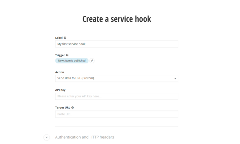Send custom payload
To change the default payload sent by service hooks, you need to create a custom action that modifies the payload before executing the service hook.
To achieve this, inherit from the default webhook action as shown in the following example:
NOTE: In order to use all available attributes in CustomWebhookActionParameters class you need to install Progress.Sitefinity.Renderer nuget package. For more information, see Widget designers.
To register your custom action in the system, you need to have a module that implements the IServiceHookActionProvider interface which returns the new action in the GetServiceHookActionsSettings() method.
After you have implemented and registered your custom action you are ready to configure your first service hook to start sending the new payload.
- Navigate to Administration » Servicehooks
- Click Create.
- Under the Action label there is a dropdown selector where you can now select your custom action (Send data to URL (Custom) in the example) instead of the default one

- With the custom action, there is a new field in the UI, API Key, which can now be configured and used in the construction of the modified payload. Here’s an example payload from the new service hook: